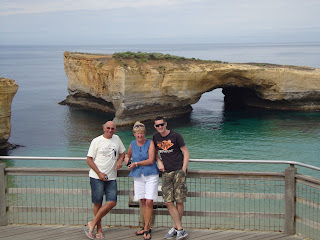We woke on the morning of January 7th to a lovely hot day, and drove inland to our first destination - the beacutiful bay of Port Campbell. Port Cambell is a seaside village towards the Western end of the Great Ocean Road - a good place to start our trip back along the Great Ocean Road.

We spent the afternoon on the beach........
 |
| Our Port Campbell accomodation |
First stop - London Arch - a natural arch in the Port Campbell National Park. It was formed by a gradual process of erosion, and until 1990 formed a complete double-span natural bridge. The arch closest to the shoreline collapsed unexpectedly on 15 January 1990, leaving two tourists stranded on the outer part until they were rescued by a helicopter. No one was injured in the event. Prior to the collapse, the arch was known as London Bridge because of its similarity to its namesake.
 |
| London Arch |
The Arch (in the background of this photo!) - formed by the sea cutting through a rock ledge
 |
| This used to be Island Archway! |
 |
| Pudding Basin Rock in the backgroud (I think!) |
 |
| Loch Ard Gorge |
And no trip on the Great Ocean Road would be complete without seeing the Twelve Apostles. The Twelve Apostles are giant rock stacks that rise majestically from the Southern Ocean and are the central feature of the rugged Port Campbell National Park. They have been created by constant erosion of the limestone cliffs of the mainland that began 10–20 million years ago. The stormy Southern Ocean and blasting winds gradually eroded the softer limestone, forming caves in the cliffs. The caves eventually became arches, and when they collapsed rock stacks up to 45 metres high were left isolated from the shore.





No comments:
Post a Comment